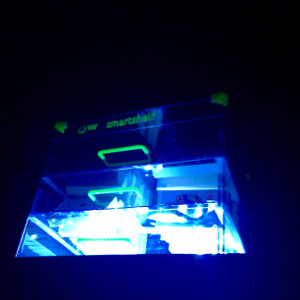
smartshelf
automatic
tracking of
inventory

Pick a card... The items in the Smartshelf are labeled with RFID tags, which allows for automatic tracking of inventory. Inventory control is instant and can be performed as often as required. The shelf is network connected and reports to a database. It is possible to support distributed inventory, with stock spread across multiple storage rooms and multiple sites.
A fun, but not very serious, use of the Smartshelf is to perform the classic card trick Pick a Card. Then the items stored in the shelf are playing cards. A person from the audience picks a card and the Smartshelf tells which card it was by running an inventory check. Magic!
RFID stands for radio-frequency identification. An RFID tag consists of a tiny antenna and a very simple microprocessor. Tags can be made very thin. It’s possible to hide them inside a normal label of plastic or paper. There is a much bigger antenna in the backplane of the Smartshelf. It produces an electromagnetic field that is sufficiently strong, not only to communicate with the tags, but also to power them. There is thus no need for batteries in the tags. When needed, they are instead energized inductively from the antenna of the Smartshelf. The simple construction of the RFID tags makes it possible to manufacture them at low cost; say, a retail price in the order of ten cents when purchased in volume.


In response to an inventory request, each tag replies with its serial number (its unique identifier). The RFID reader uses a special anti-collision protocol to distinguish individual responses in the cacophony created by a shelf full of tags. The unique identifiers are used as keys to index into a database. This is a very flexible scheme. The database provides per-item information that is suitable for the kind of items that are kept in the Smartshelf.
The Smartshelf uses a network connection to report the inventory. Distributed inventory is supported in a straightforward manner by multiple shelves reporting to a single database. It does not really matter if there are multiple shelves in the same storage room, if the shelves are located on different floors in the same building or on different sites around the world.

The demonstrator, which is shown in the pictures on this page, is mobile. The database server is located in Copenhagen. As you can see in the pictures, the items are cardboard boxes, 100 x 60 x 15 mm in size. Each cardboard box has a playing card glued to it. The information, which is associated with each item (cardboard box) relates to the playing card: its rank, suit and the colour of the deck (currently there are two decks in the database: a blue and a pink one). In addition, there is information about the type of RFID tag used. That would typically not be a very interesting piece of information, but for our present purposes it is used to assess the performance of different kinds of tags.
The most recent inventory check made by the demonstrator is reported on-line, click here.
We would like to hear from you! We would be more than happy to demonstrate the smartshelf. The next step is to perform field tests with a significantly larger unit. We are looking for partners, going forward. If you are a provider of storage systems and you are looking for a way of augmenting your products, we would like to get in contact with you. Or, perhaps, your operation would benefit from automated tracking of inventory. If you are willing to share your requirements, this would be most valuable to us in the further development of the smartshelf. We currently evaluate additional antennas and RFID readers with long-range specifications. If you provide solutions in that space, you are most welcome to contact us.